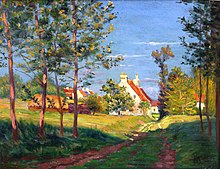Léo Gausson
Léo Gausson (born February 14, 1860 in Lagny-sur-Marne , † October 27, 1944 ibid) was a French painter .
Léo Gausson began his training as a sculptor in evening classes at the École nationale supérieure des arts décoratifs in Paris . He also experimented with woodcuts and etchings, but his main interest was painting.
The Spanish painter Antonio Cortes (1827-1908) introduced him to outdoor painting in the style of the Barbizon school . Gausson became a follower of Neo-Impressionism , the most important representatives of which were Georges Seurat and Paul Signac . In 1885, Gausson explained the principles of Neo-Impressionism in a long letter to Émile Zola . He took part in numerous avant-garde exhibitions.
Gausson illustrated books by Adolphe Retté, wrote a collection of novellas "Histories vertigineuses" (dizzying stories).
In 1899 he opened an exhibition of his paintings in the Theater Antoine. Gausson designed a memorial for the road builder Charles Colinet in Fontainebleau Forest. In 1900 he became a member of the Académie des beaux-arts .
In 1901 he came to Africa as an official in the colonial administration of French Guinea and stayed there for eight years.
After returning to France, he settled in Brittany. He spent the last years of his life with his nephew in his birthplace Lagny-sur-Marne.
literature
- Gausson, Leo . In: Ulrich Thieme (Hrsg.): General Lexicon of Fine Artists from Antiquity to the Present . Founded by Ulrich Thieme and Felix Becker . tape 13 : Gaab-Gibus . EA Seemann, Leipzig 1920, p. 282 ( Textarchiv - Internet Archive ).
- Micheline Hanotelle Fonteneau: Léo Gausson (1860–1944), un peintre méconnu du Post-impressionniste ; Presses Universitaires du Septentrion: 2000: ISBN 9782729535926
Web links
- Léo Gausson. Biographical data and works in the Netherlands Institute for Art History (Dutch)
- Léo Gausson website
| personal data | |
|---|---|
| SURNAME | Gausson, Léo |
| BRIEF DESCRIPTION | French landscape and genre painter |
| DATE OF BIRTH | February 14, 1860 |
| PLACE OF BIRTH | Lagny-sur-Marne |
| DATE OF DEATH | October 27, 1944 |
| Place of death | Lagny-sur-Marne |

